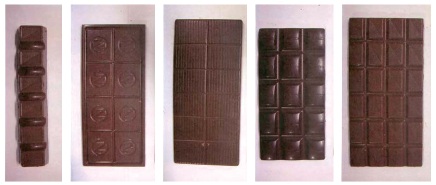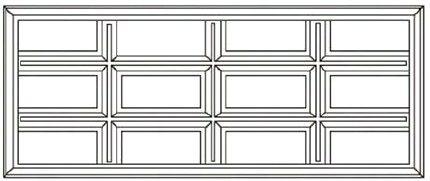Hershey Chocolate and Confectionary Corporation ("Hershey's") recently gained registered trademark protection for the design and configuration of its candy bar after prevailing in an appeal before the Trademark Trial and Appeal Board (the TTAB).1 The candy maker sought protection for "twelve...equally-sized recessed rectangular panels arranged in a four panel by three panel format with each panel having its own raised border within a large rectangle," and while the individual design elements alone were insufficient to garner trademark protection on the grounds that each element is merely a functional configuration of the candy bar, the TTAB ruled that the "overall combination" of the design features entitled the candy maker to registered trademark protection. The TTAB also ruled that Hershey’s had acquired the requisite "secondary meaning" for trademark protection in "production-design" trade dress. The decision has some interesting implications on the scope of product-design trademark protection, particularly as it relates to foods. First, it is important to understand how and why trademark law protects this type of food product design and the scope of the protection.
A trademark is any word, name, symbol or device, or any combination thereof, used to identify and distinguish goods from the goods sold or made by others.2 Hershey's has a number of conventional registered trademarks, such as "Hershey's"3 and "Hershey's Kisses"4 for chocolate candy. In this case, Hershey's sought protection not for the word "Hershey's" or the Hershey's logo, but for the unique candy bar design that had been in use for more than 40 years. This type of trademark protection falls under the category of trademark law called "trade dress."
Trade dress includes trademark protection for both “product packaging” and "product design." "Product-packaging" trade dress "is composed of the overall combination and arrangement of the design elements that make up the product’s packaging, including graphics, layout, color, or color combinations."5 "Product-design" trade dress – the type of trade dress at issue in In re Hershey – "covers a product’s shape or configuration and other product design features."
For both types of trade dress, the design or package feature cannot serve as a trademark if it is "functional," that is, "if it is essential to the use or purpose of the article or if it affects the cost or quality of the article," or if "exclusive use of the feature would put competitors at a significant non-reputation-related disadvantage.6
The examining attorney for the U.S. Patent and Trademark Office (USPTO) refused Hershey’s trademark application for its candy bar design based on the functionality doctrine, reasoning that "the flat rectangular shape and the 'scoring' of [Hershey's] candy bar into smaller pieces represent functional features which constitute an absolute bar to registration."7 On appeal, the TTAB agreed that "that scoring or segmenting candy bars, in and of itself, serves a useful function to enable the consumer to break the candy bar into smaller pieces for consumption." It also recognized that candy bars come in all sorts of segmented shapes, "comprised of squares, rectangles, triangles, ovals, and the like," which are "often arranged in a variety of common symmetrical patterns, including, one by six, two by four, three by ten, four by six, etc.," to conclude that "candy bar segmentation is a functional feature of such goods."
 8
8
But, the TTAB also noted that Hershey's "is not seeking to register a segmented rectangular candy bar of no particular design. Rather, [Hershey's] is seeking to register a candy bar comprising all of the elements shown in the drawing and in the description of the mark, i.e., 'twelve...equally-sized recessed rectangular panels arranged in a four panel by three panel format with each panel having its own raised border within a large rectangle.'"
 9
9
While the rectangular shape or segmentation of the candy bar is a functional feature of the design, the TTAB observed that it must balance these functional elements against any nonfunctional elements to determine whether the mark as a whole is functional." Here, the TTAB identified other elements of the Hershey candy bar design, including the 12 recessed rectangles with a raised border design in a four by three panel format. The TTAB recognized that "candy makers often embellish their candy bars with decorative elements," and that "these raised borders and ridges decorate and embellish what otherwise would be a simple rectangular shape with a four by three pattern." Here, there was no evidence of any other candy maker using the particular combination of recessed rectangles with a raised border that Hershey's used.
The TTAB ultimately reversed the examining attorney's refusal to register the mark on the basis of functionality, observing: "When the significance of design of the recessed rectangles with a raised border is balanced against the rectangular shape including segments, we find that the mark as a whole is not essentially functional. The prominent decorative recessed rectangle and raised border design reduces the degree of utility present in the overall design of the mark so as to remove it from the category of functional...."
After clearing the functionality hurdle, Hershey's next had to show that its product design had achieved the requisite "secondary meaning." In the analytical framework of trade dress, there is a key difference between “product-design” trade dress and "product-packaging" trade dress. "Product-packaging" trade dress can earn trademark protection if it is either (1) "inherently distinctive" or (2) if it acquires "secondary meaning."10 "Product-design" trade dress, on the other hand, faces a higher bar and can only be protected as a trademark if it achieves "secondary meaning." A mark is "inherently distinctive" if "its intrinsic nature serves to identify a particular source."11 Given that Hershey’s sought trademark protection as a product-design, it had to prove "secondary meaning" – that is, Hershey’s had to show that its candy bar design had acquired distinctiveness over a period of time such that its relevant consumers (chocolate consumers) view the configuration as a trademark.
The examining attorney for the USPTO refused registration to Hershey's trademark application for its candy bar design on the grounds that the design had not established this "acquired distinctiveness" or "secondary meaning." A product design applicant faces a heavy burden in attempting to establish acquired distinctiveness.12 "Ultimately, to establish acquired distinctiveness, an applicant must show that the product configuration sought to be registered is perceived by consumers as not just the product but, rather, that the design identifies the producer or source of the product."13
Trademark law is silent on the amount of evidence required to show secondary meaning,14 leaving "the exact degree of proof necessary to qualify a mark for registration to the judgment of the Patent Office and the Courts."15 Here, the TTAB reversed the examining attorney’s refusal to register Hershey’s application because the TTAB found that Hershey's established a prima facie case that the candy bar configuration had acquired distinctiveness. The TTAB considered as direct evidence a survey of relevant consumers (those who had both purchased a chocolate bar in the past six months and plan on purchasing a chocolate bar in the next six months), who were asked to identify the maker of the "four by three" panel candy bar configuration. Forty-two percent of survey participants correctly identified Hershey's as the maker of the candy bar, a percentage that is higher compared to other cases in which survey results were used to establish secondary meaning.16 The TTAB also considered circumstantial evidence submitted by Hershey's, including evidence that Hershey’s had been using the mark for over 40 years, sales figures over a 12-year period exceeding $4 billion dollars, and $186 million in advertising products embodying the candy bar configuration. Lastly, the TTAB also considered a purported attempt by a third party to copy the design of the candy bar configuration for the shape of a brownie baking pan, where the words "CHOCOLATE" appear in each rectangle instead of "HERSHEY'S."
The Hershey's case represents another development in the evolving field of trade dress trademark protection. As the courts continue to leave clues to avoiding the functionality barrier and to proving either inherent distinctiveness or acquired secondary meaning, trademark applicants will have more ways to protect unique design features in their products.
1 In re Hershey Chocolate and Confectionary Corporation, (T.T.A.B. 2012) (nonprecedential).
2 15 U.S.C. 1127.
3 HERSHEY’S, Registration No. 4,033,631.
4 HERSHEY’S KISSES, Registration No. 1,549,371.
5 Jeffery A. Handelman, “Stretching Trademark Law to Protect Product Design and Packaging,” 4 No. 3 Landslide 30 (January/February, 2012). Landslide is a publication of the ABA Section of Intellectual Property Law.
6 Qualitex Co. v. Jacobson Prods. Co., 514 U.S. 156, 195 (1995) (quoting Inwood Laboratories, Inc. v. Ives Labs., Inc., 456 U.S. 844, 850 n.10 (1982)).
7 In re Hershey, at 6.
8 Id. at p. 8 (citing Hershey’s May 3, 2010 Response to Office Action, at 8-18).
9 Id. at 2. See also U.S. Trademark Application Serial No. 77,809,223 (filed August 29, 2009).
10 Wal-Mart Stores, Inc. v. Samara Brothers, Inc., 529 U.S. 205, 212 (2000).
11 Id. at 210. The Court of Appeals for the Federal Circuit and the TTAB consider four factors to determine whether a design is inherently distinctive, including whether the mark is: (1) a “common” basic shape or design; (2) unique or unusual in the field in which it is used; (3) a mere refinement of a commonly-adopted and well-known form of ornamentation for a particular class of goods viewed by the public as a dress or ornamentation for the goods; and (4) capable of creating a commercial impression distinct from the accompanying words. See Seabrook Foods, Inc. v. Bar-Well Foods, Ltd., 568 F.2d 1342, 1344 (Fed. Cir. 1977). See also TMEP § 705.05 (5th ed. Sept. 2007).
12 Yamaha Int’l Corp. v. Hoshino Gakki Co. Ltd., 840 F.2d 1572, (Fed. Cir. 1988).
13 In re Hershey, at 13.
14 See 15 U.S.C. § 1052(f); Yamaha, 840 F.2d at 1581.
15 Yamaha, 840 F.2d at 1581 (quoting In re Owens-Corning Fiberglas Corp., 774 F.2d 1116, 1125 (Fed.Cir.1985)).
16 In re Hershey, at 14-15.